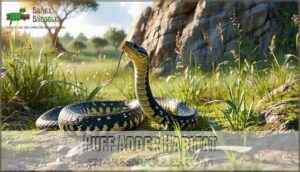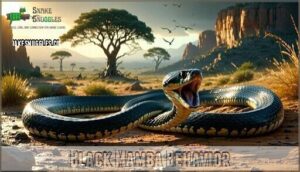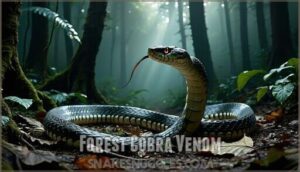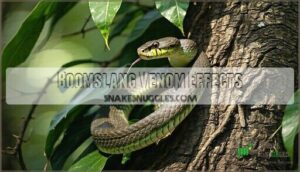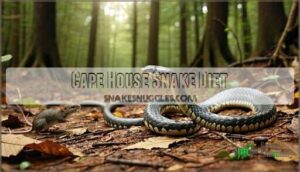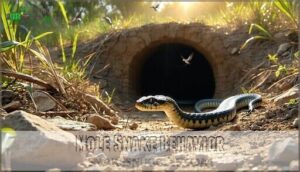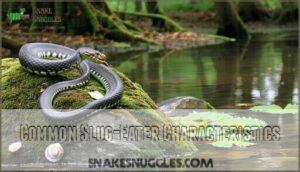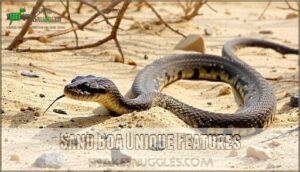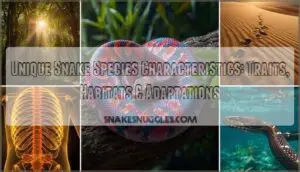This site is supported by our readers. We may earn a commission, at no cost to you, if you purchase through links.
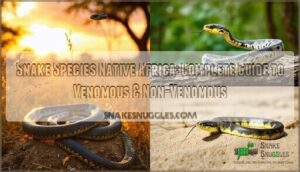
The continent’s diverse ecosystems support everything from the lightning-fast black mamba and deadly puff adder to gentle ball pythons and colorful sand boas.
While venomous species like forest cobras and boomslangs grab headlines, you’re more likely to encounter harmless varieties like cape house snakes or mole snakes.
Each species has evolved unique adaptations for Africa’s varied landscapes, from rainforests to deserts, which is crucial for confident coexistence.
Understanding which snakes pose real threats versus harmless look-alikes could mean the difference between unnecessary panic and confident coexistence, and recognizing the importance of varied landscapes is key.
Table Of Contents
- Key Takeaways
- Venomous Snakes Found
- Non-Venomous Snakes
- Snake Species Distribution
- Snake Conservation Status
- African Snake Identification
- Frequently Asked Questions (FAQs)
- How many snake species are there in Africa?
- What is Africa’s deadliest snake?
- What pythons are native to Africa?
- Are king cobras native to Africa?
- How do African snakes reproduce and mate?
- What do African snakes eat primarily?
- How long do African snakes typically live?
- When are African snakes most active daily?
- How do African snakes survive winter months?
- Conclusion
Key Takeaways
- You’ll encounter mostly harmless snakes – About 57% of Africa’s 170+ snake species are venomous, but you’re more likely to spot non-venomous varieties, like ball pythons and house snakes, that actually help control rodent populations around your home.
- Learn to identify the real threats – Venomous species, like black mambas, puff adders, and forest cobras, pack deadly toxins, but proper identification skills help you distinguish dangerous snakes from harmless look-alikes that pose no threat.
- Habitat knowledge keeps you safer – Understanding where different species live helps you prepare for encounters, whether you’re dealing with burrowing mole snakes in grasslands or tree-dwelling boomslangs in forested areas.
- Conservation matters for ecosystem balance – Many African snakes face threats from habitat loss and the pet trade, but protecting these species ensures they can continue their vital role in controlling pests and maintaining ecological balance.
Venomous Snakes Found
Africa’s venomous snakes pack some of the world’s most potent toxins, from the lightning-fast Black Mamba to the perfectly camouflaged Puff Adder waiting in your backyard.
You’ll encounter species that can kill within minutes or cause slow, agonizing hemorrhages—knowing which is which could save your life.
Puff Adder Habitat
Throughout sub-Saharan Africa, you’ll find the Puff Adder thriving in diverse environments where African snake species commonly establish territories.
Africa’s deadliest serpents lurk where you least expect them—your garden might be their next hunting ground.
This adaptable viper demonstrates remarkable Desert Adaptation while maintaining strong populations across varied landscapes.
Key Puff Adder habitat preferences:
- Savannah Grasslands – Dense vegetation provides perfect camouflage for ambush hunting
- Rocky Outcrops – Crevices offer shelter and temperature regulation opportunities
- Urban Encounters – Suburban areas with adequate cover attract these opportunistic hunters
Their success in Grassland Ecology stems from abundant rodent populations and effective concealment strategies.
The Puff Adder’s ability to thrive is closely tied to its venom characteristics, which play a vital role in its hunting and survival tactics.
Black Mamba Behavior
You’ll find the black mamba displays remarkable aggressive posturing when threatened, rearing up with its distinctive black mouth gaping wide.
These African snake species use lightning-fast hunting tactics, striking prey with precision venom delivery.
Their defensive mechanisms include speed up to 16 kph and intimidating displays. Black mamba behavior shows minimal social interactions, preferring solitary hunting across savannas and rocky terrain.
Forest Cobra Venom
Why does Forest Cobra venom pack such a deadly punch? This African venomous snake delivers massive doses of neurotoxic venom that can kill within 30-120 minutes.
Forest Venom contains complex snake toxins that cause rapid paralysis and respiratory failure. The Forest Cobra’s venom is a result of its postsynaptic neurotoxin properties, making it highly dangerous to humans.
Key Forest Cobra venom effects:
- Neurotoxic paralysis – Venom Effects include progressive muscle weakness starting from the head downward
- Massive venom yield – Up to 1,100mg per bite, far exceeding most venomous snakes
- Rapid onset – Snake Toxins begin affecting victims within minutes of Cobra Bites
Rhinoceros Viper Characteristics
You’ll easily spot the Rhinoceros Viper by its triangular scales and distinctive horn-like projection on its nose.
This master of Snake Camouflage blends perfectly into rainforests and grasslands across Africa.
The Rhinoceros Viper’s Venom attacks cell tissue and blood vessels, causing dangerous internal bleeding.
Its Viper Behavior includes remaining motionless for hours, waiting for unsuspecting prey to wander close.
Boomslang Venom Effects
Boomslang venom packs a deadly punch that’ll make your blood refuse to clot.
This killer snake turns your blood into water—no clotting, just endless bleeding until you’re done.
This rear-fanged African venomous snake delivers hemotoxic effects through potent venom composition that disrupts your body’s clotting mechanisms.
- Hemorrhaging – Internal bleeding occurs within hours of snake bite
- Coagulation failure – Blood won’t clot, causing continuous bleeding
- Tissue damage – Venom potency destroys blood vessel walls
- Delayed symptoms – Toxicity levels build slowly, masking danger
- Organ failure – Severe cases affect kidneys and brain function
Understanding the venom composition and its venom effects mechanisms is vital in treating snakebites effectively.
Non-Venomous Snakes
You’ll find that Africa’s non-venomous snakes play a big role in keeping pests like rodents and insects under control, often right in your backyard or garden.
Don’t be surprised if you spot a harmless house snake on mouse patrol or a ball python curled up tighter than your favorite pair of socks.
Cape House Snake Diet
You’ll find Cape House Snake diet centers on rodent control, making them valuable allies in your home.
These African house snake specialists use stealth hunting tactics to capture mice, rats, and small birds.
Their feeding habits include constricting prey before swallowing whole.
Cape House Snake care often involves understanding their snake product needs.
| Prey Type | Hunting Method | Feeding Frequency |
|---|---|---|
| Mice/Rats | Ambush constriction | Weekly intervals |
| Small birds | Nocturnal stalking | Bi-weekly feeding |
| Lizards | Patient waiting | Monthly occasions |
| Bird eggs | Careful climbing | Seasonal opportunity |
| Insects | Opportunistic strikes | Emergency nutrition |
Snake foraging behavior shows remarkable prey preference adaptability.
Cape House Snake hunting tactics involve waiting motionless near rodent pathways.
Their snake feeding habits make them perfect natural pest controllers around human settlements.
Ball Python Habitat
Ball Python habitats span diverse African landscapes, from forest floors to savannah grass.
You’ll discover these African snakes in rocky outcrops across sub-Saharan regions, though they avoid desert sands.
Tree canopies rarely house Ball Pythons since they’re terrestrial creatures.
African reptiles like these prefer grasslands and woodland edges where snake species diversity thrives, offering abundant rodent prey for their constricting lifestyle.
Mole Snake Behavior
When threatened, you’ll witness the Mole Snake’s aggressive nature firsthand.
These non-venomous African snakes rely on powerful constriction and razor-sharp teeth for hunting. Their underground behavior makes them fascinating predators worth understanding.
The Mole Snake’s behavior is influenced by its snake behavior patterns.
Mole Snake behavioral traits include:
- Burrowing Techniques – Excavates extensive tunnel systems using muscular bodies
- Hunting Strategies – Ambushes prey from underground burrows at night
- Snake Camouflage – Blends perfectly with soil and rock formations
- Mole Snake Diet – Primarily hunts rodents, small mammals, and ground-dwelling birds
- Underground Behavior – Spends daylight hours hidden in self-made tunnels
Common Slug-Eater Characteristics
Throughout southern Africa’s diverse landscapes, you’ll encounter the Common Slug-Eater, a specialized predator that’s evolved remarkable hunting adaptations for its unique diet.
The species has several key characteristics that enable it to thrive in its environment, which can be summarized as follows:
| Characteristic | Description | Benefit |
|---|---|---|
| Diet Specialization | Exclusively feeds on snails and slugs | Reduces competition with other snake species |
| Jaw Structure | Elongated teeth for extracting prey | Efficient removal of mollusks from shells |
| Hunting Behavior | Nocturnal foraging patterns | Matches gastropod activity periods |
| Habitat Preference | Moist environments near water sources | Optimizes access to slug populations |
This African species demonstrates nature’s precision in creating the perfect slug predator through specialized anatomy and behavioral adaptations.
Sand Boa Unique Features
Three fascinating snake species native to Africa showcase the Sand Boa’s incredible adaptability.
You’ll find these masters of camouflage skills using advanced burrowing techniques in sandy terrain.
Their nocturnal behavior helps them hunt effectively while their Sand Boa habitat provides perfect cover.
These defensive mechanisms make them remarkable survivors in African wildlife ecosystems, utilizing their advanced burrowing techniques.
Snake Species Distribution
You’ll find Africa’s snakes scattered across remarkably diverse habitats, from the Sahara’s sandy dunes to dense rainforest canopies.
Understanding where each species lives helps you identify what you’re likely to encounter in different regions across the continent, which involves complete concepts of species distribution and regional diverse habitats.
Puff Adder Geographic Range
You’ll find the Puff Adder across more African terrain than any other venomous snake species.
This remarkable Geographic Spread covers 40+ countries from Morocco to South Africa’s Western Cape.
Sub-Saharan Regions dominate their range, though they avoid true deserts and dense rainforests.
African venomous snakes rarely match this distribution – Puff Adder Migration patterns show they’ve colonized savannahs, grasslands, and cultivated areas.
Their Snake Habitat preferences make them incredibly adaptable across diverse African wildlife ecosystems.
Understanding the snake geographic range map is essential for grasping their habitat preferences and distribution patterns, which involve rattlesnake habitats.
Cape Cobra Habitat
Cape Cobra habitat spans southern Africa’s diverse landscapes, from South Africa’s Cape Ecology to Botswana’s arid regions.
You’ll find these African venomous snakes in fynbos, grasslands, and semi-desert areas. Unlike other snake habitats, Cape Cobras adapt well to human settlements.
Snake Denning occurs in termite mounds and rock crevices. Habitat Loss threatens populations, though they’re less affected than Cape House Snake.
Desert Adaptation helps them survive harsh conditions, while Cobra Migration patterns follow seasonal prey availability supporting snake conservation efforts. Snake conservation is crucial for their survival.
Boomslang Distribution
You’ll find the Boomslang across sub-Saharan Africa, from South Africa’s grasslands to Tanzania’s woodlands.
This rear-fanged snake shows remarkable geographic spread throughout Zimbabwe, Botswana, and Kenya.
Unlike many African snake species with limited ranges, Boomslang habitat extends through diverse ecosystems.
Their distribution pattern follows tree coverage, as these arboreal hunters prefer forested areas and savanna woodlands for maximum hunting success.
Southern African Python Range
You’ll discover the Southern African Python across a vast territory spanning multiple countries in southern Africa.
This impressive snake species thrives in diverse Python Habitat conditions, making it one of the most adaptable reptiles in African ecosystems.
The Southern African Python’s range includes:
- South Africa – Found throughout most provinces
- Zimbabwe – Common in savannas and woodland areas
- Mozambique – Inhabits coastal forests and inland regions
- Botswana – Present in northern territories
This African rock python demonstrates remarkable adaptability within African Ecosystem boundaries, supporting ongoing Wildlife Research and Reptile Conservation efforts.
Sahara Sand Viper Habitat
Thriving in North Africa’s harshest desert regions, the Sahara Sand Viper has mastered life among shifting sand dunes and arid landscapes.
You’ll find these desert snakes buried beneath sandy terrains, using specialized scales for locomotion.
Their viper denning behavior involves creating shallow burrows in loose sand, where they ambush lizards and small mammals.
This remarkable desert ecology adaptation makes them perfectly suited for Sahara snake ecology survival.
Snake Conservation Status
You’ll find that many African snake species face serious conservation challenges, from habitat loss to the pet trade.
Understanding these threats helps you appreciate why protecting these remarkable serpents matters for Africa’s ecosystems, and this is why conservation is crucial.
Ball Python Threats
Ball Python populations face mounting pressure from multiple threats across West and Central Africa.
The Pet Trade remains the primary concern, with over 3.6 million specimens exported between 1997-2018.
Habitat Loss from deforestation and agricultural expansion shrinks available territory.
Poaching Risks include hunting for meat, skins, and traditional medicine.
Climate Change intensifies through extreme weather events and bush fires.
Conservation Efforts focus on trade regulation and habitat protection for these vulnerable snake species native to Africa.
Understanding proper ball python care is essential for reducing the demand for wild-caught specimens and promoting sustainable pet trade practices.
The main goal is to address the Pet Trade, Habitat Loss, Poaching Risks, and Climate Change to ensure the well-being of Ball Python populations, and support Conservation Efforts.
Moorish Viper Conservation
You’ll find the Moorish Viper faces mounting conservation challenges as habitat destruction and human encounters threaten populations.
This Near Threatened species often gets killed during road crossings or captured for snake charming practices.
Conservation efforts focus on habitat preservation and species research to protect remaining populations.
Wildlife protection programs emphasize viper ecology studies, helping researchers understand their critical role in African ecosystems and develop effective snake conservation strategies.
Understanding viper conservation methods is essential for protecting this species.
Viperine Snake Habitat
When pollution and habitat changes threaten ecosystems, you’ll find Viperine Snakes struggling to adapt.
These serpents prefer freshwater environments near rivers and lakes, but they’re incredibly sensitive to environmental shifts.
Rocky Outcrops and Sandy Dunes provide essential shelter, while Arid Landscapes offer hunting grounds.
Unlike true Venomous Snakes, they’re often mistaken for dangerous species, making conservation efforts challenging in Desert Ecology zones.
Iberian False Smooth Snake Status
You’ll find the Iberian False Smooth Snake listed as a species of conservation concern, though it’s actually native to Europe, not Africa.
This Western Montpellier Snake faces habitat loss from agricultural expansion and urban development.
While venomous, it poses minimal threat to humans due to rear fangs and low toxicity, and conservation efforts focus on habitat protection and species research to monitor population decline trends across its range.
Brown House Snake Interaction
Brown House Snake interaction with humans demonstrates peaceful coexistence in African communities.
You’ll encounter these non-venomous African Brown Snakes around homes, where they control rodent populations effectively.
Their timid Snake Behavior makes Snake Handling unnecessary—they’ll retreat when spotted.
These African house snakes require minimal Human Safety precautions, making them ideal for natural Coexistence Strategies.
Unlike venomous snake species native Africa, Brown House Snakes pose no threat, though proper Pet Care knowledge helps distinguish them from dangerous species during any snake interaction, ensuring Human Safety.
African Snake Identification
You’ll need to identify snakes correctly to stay safe in Africa’s diverse landscapes.
Learning key features like head shape, body patterns, and behavioral cues can mean the difference between admiring a harmless species and avoiding a deadly encounter.
Identifying Venomous Snakes
You can’t rely on head shape, pupil shape, or scale patterns to identify venomous snakes in Africa. These visual cues often mislead even experienced observers.
Professional snake identification requires examining fang structure and multiple anatomical features together.
The Cape cobra’s neurotoxic venom signs include rapid paralysis, while cytotoxic species cause severe tissue damage.
A helpful resource is a snake identification guide for further assistance.
When facing snake bites, immediate medical attention trumps field identification attempts.
Non-Venomous Snake Characteristics
You’ll easily recognize nonvenomous snakes by their rounded pupils, smooth scale patterns, and gentle constriction methods.
African Brown Snake and African Green Snake showcase typical defensive behaviors like coiling defensively rather than striking.
These species display remarkable arboreal adaptations with slender bodies for tree navigation.
Diet variations include rodents, birds, and insects.
Unlike venomous species, their snake physical characteristics feature less pronounced heads and longer, more flexible bodies suited for their hunting style, with smooth scale patterns and gentle constriction methods.
Snake Pattern Recognition
Pattern recognition starts with understanding snake coloration and scale patterns.
Look for distinctive markings like the African Green Snake’s uniform emerald hue versus the Boomslang’s variable green shades.
Snake camouflage often includes bands, stripes, or diamond shapes.
Texture analysis reveals smooth versus keeled scales.
Pattern variations help distinguish species – some display bold contrasts while others show subtle gradations.
Snake skin patterns frequently mirror their habitat’s colors and textures, which can include diamond shapes.
Horned Adder Identification
You’ll spot the Horned Adder by its distinctive horn-like scales above each eye and triangular head shape.
This venomous snake species displays excellent camouflage in desert habitat, blending seamlessly with sandy terrain.
Watch for its unique sidewinding locomotion and black-tipped tail used for luring prey.
The Horned Adder’s thick body and keeled snake scales create a rough texture that aids identification among African snake species.
Mole Snake Recognition
You’ll recognize the Mole Snake by its robust, cylindrical body and smooth, glossy scales that create excellent snake camouflage.
These African snake species display variable snake patterns from brown to black, helping them blend with mole habitat underground.
Their burrowing behavior involves powerful muscles for digging, while their blunt snout distinguishes them from venomous species.
Remember: aggressive temperament doesn’t mean venomous in snake identification, and this is crucial for snake camouflage.
Frequently Asked Questions (FAQs)
How many snake species are there in Africa?
Savvy serpent seekers should know that Africa is home to more than 400 snake species, with only about 30 venomous varieties capable of seriously threatening you.
That’s fewer dangerous snakes than you’d think roaming the continent’s diverse landscapes.
What is Africa’s deadliest snake?
The Black Mamba’s your biggest threat—delivering lethal neurotoxic venom that’ll kill you within 20 minutes. This lightning-fast serpent reaches 16 kph and grows fourteen feet long.
What pythons are native to Africa?
Africa’s got around 20 python species, but you’ll mainly encounter the Southern African Python, which stretches up to 20 feet. Ball pythons are your most recognizable species, curling defensively when threatened.
Are king cobras native to Africa?
No, king cobras aren’t native to Africa.
You’ll find them in Southeast Asia and India instead.
Africa has its own cobra species like the Cape cobra and Egyptian cobra, but the king cobra calls Asian forests home.
How do African snakes reproduce and mate?
You’ll find African snakes reproduce through internal fertilization, with males using hemipenes to transfer sperm. Most species lay eggs, though some bear live young after gestation periods varying by species.
What do African snakes eat primarily?
Like nature’s ultimate survivors, you’ll find African snakes aren’t picky eaters—they’re opportunistic predators.
Most species hunt rodents, birds, frogs, and lizards, while constrictors tackle larger mammals and venomous species prefer smaller prey.
How long do African snakes typically live?
You’ll typically find them living anywhere from 8 to 30 years, depending on the species.
Larger species, such as the African Rock Python, can live for 20-25 years in feral and up to 30 years in captivity, while smaller species often live shorter lives.
When are African snakes most active daily?
Most African snakes hunt nocturnally, prowling through darkness when temperatures cool and prey emerges.
You’ll spot desert species like horned vipers active at night, while forest cobras prefer dawn and dusk hunting periods for maximum success.
How do African snakes survive winter months?
Most African snakes don’t truly hibernate since they’re in warm climates year-round.
You’ll find them brumating instead—slowing down, seeking shelter under rocks or logs, and becoming less active during cooler months while still occasionally emerging to hunt.
Conclusion
Knowledge is power, but wisdom is knowing when to use it.
Understanding the diverse snake species native to Africa transforms fear into informed respect for these remarkable reptiles.
You’ve now explored venomous giants like black mambas and puff adders alongside gentle ball pythons and colorful sand boas.
This knowledge helps you distinguish real threats from harmless look-alikes, promoting safer outdoor adventures.
Remember, most encounters involve non-venomous species that play essential ecological roles controlling rodent populations across Africa’s varied landscapes, highlighting the importance of informed respect and ecological roles.
- https://repfocus.dk/index.html
- https://www.africansnakebiteinstitute.com/posters/
- https://www.mpalalive.org/field_guide/view/puff_adder
- https://eswatiniantivenom.org/dangerous-snakes-of-west-africa-online-fact-sheets/puff-adder/
- https://www.snakesociety.nl/jaargangen/1999e/Litteratura%20Serpentium%2019-3%20088-090%20Bakker%20and%20Bakker,%20Bitis%20arietans,%20the%20Puff%20adder.pdf

